The Transformation of Clay Minerals During Diagenesis and Low-grade Metamorphism a Review
- Published:
Diagenesis and very low form metamorphism in a seven,012 m-deep well Hongcan 1, eastern Tibetan plateau
Swiss Periodical of Geosciences volume 105,pages 249–261 (2012)Cite this commodity
Abstract
This study uses clay mineral assemblages, illite "crystallinity" (IC), chlorite "crystallinity" (CC), illite polytypes, the b prison cell-dimension of K-white mica, mineral geothermo-geobarometers and homogenization temperatures of fluid inclusions to investigate the transition from diagenesis to metamorphism in a 7 km thick Triassic flysch sequence in the well Hongcan 1, eastern Tibetan plateau. The 7,012.eight grand deep borehole penetrated flysch of Upper to the Middle Triassic age and represents a unique hazard to narrate low temperature metamorphic processes in an unusually thick sedimentary sequence developed on thickened continental crust. Mineral assemblage assay reveals a burial metamorphic blueprint with kaolinite and chlorite/smectite mix-layer phases present in the upper 1,500 grand, and illite/smectite mixed-layer phases extending to a depth of 3,000 g. The metamorphic index mineral, graphite, was detected in sedimentary rock below 5,000 m using Raman spectroscopy. In that location exists a good correlation between IC and CC inside the prograde burial sequence; with CC anchizonal boundaries of 0.242 and 0.314°2θ (upper and lower boundaries, respectively) corresponding to Kübler'south IC limits at 0.25 and 0.42°2θ. Illite polytypism also shows an increase in the 2M 1 polytype with increasing depth, with ca. 60 % iiM 1 abundance compared to the 1M type at the surface, to 100 % 2One thousand one at the lesser of the borehole. Fluid inclusion analysis evidence HHC-rich bearing fluids correspond to the diagenetic zone, CH4-rich bearing fluids announced at transitional zone from diagenetic to low anchizone and H2O-rich bearing fluids marker the high anchizone to epizone. Based on chlorite chemical geothermometer, calcite–dolomite geothermo-barometers as well as homogenization temperature of fluid inclusions, a paleotemperature range of 118–348 °C is estimated for the well with a pressure facies of low to intermediate type.
Introduction
The Triassic flysch of the Tibetan plateau preserves an important phase of tectono-thermal evolution that spans the closure of Paleo-Tethys and the formation of the Himalayas. The state of diagenesis and metamorphism of the Triassic flysch has been investigated largely by the thin department report of samples from surface outcrops (Dong et al. 1986). However, a detailed belittling study of unweathered samples from depth has not still been undertaken. X-ray diffractometry based methods (e.g. Kübler 1964; Frey 1987) suitable for characterizing mineral assemblages in more detail have only been applied to five samples located far from the Hongcan 1 borehole (Xia 1993).
Since 2002 the eastern Tibetan plateau has been called as a new target expanse for oil and gas exploration, and therefore the diagenetic to low temperature metamorphic history of the Triassic flysch is of economical importance (Yang and Liu 2005). Currently, many aspects concerning the state and cause of metamorphism in the Triassic flysch are debated, with options ranging from a complete lack of metamorphism (Yang and Liu 2005) to diagenetic metamorphism (Chen et al. 2001), anchimetamorphism (Xia 1993; Wang et al. 2008), local metamorphism in the area of the Danba dome (You et al. 2006; Zhou et al. 2008), regional subgreen schist-facies metamorphism (Dong et al. 1986), regional low-temperature dynamic metamorphism (Bureau of geology and mineral resources of Sichuan province 1991) and low-course regional dynamic metamorphism (Xu et al. 1992). Such metamorphic anomalies have been attributed to the circulation of hydrothermal fluids related to tectonic deformation, such as activity along the Longmenshan fault (cause keen Sichuan earthquake on May 12, 2008) and other detachments in the Triassic flysch (Xu et al. 1992, 2007). Besides unclear is the relationship betwixt metamorphism and magmatic activity since the Mesozoic (Chung et al. 2005; She et al. 2006).
A 7,012.eight m deep well called Hongcan 1 was drilled during 2005–2006 in lodge to probe the depth of the Tibetan plateau every bit well as to explore for oil and gas in that area. The well Hongcan 1 is located within the Hongyuan County, north of Sichuan province, on the eastern margin of Tibetan plateau. Triassic flysch occurs throughout the well and represents the typical flysch sequence (200–245 Ma) of the Qingzang-Dianxi fold region located on the northern Tibetan plateau, western Communist china (>410,000 kmtwo, see Fig. one). The purpose of this paper was to investigate the diagenetic to very depression course metamorphism overprint of this particularly thick Triassic flysch sequence in the well Hongcan 1 using a range of accepted geothermal indicators which have been widely used by many researchers since 1980s. Based on these new analytical results the thermal evolution of the Triassic flysch of the Tibetan plateau is addressed.
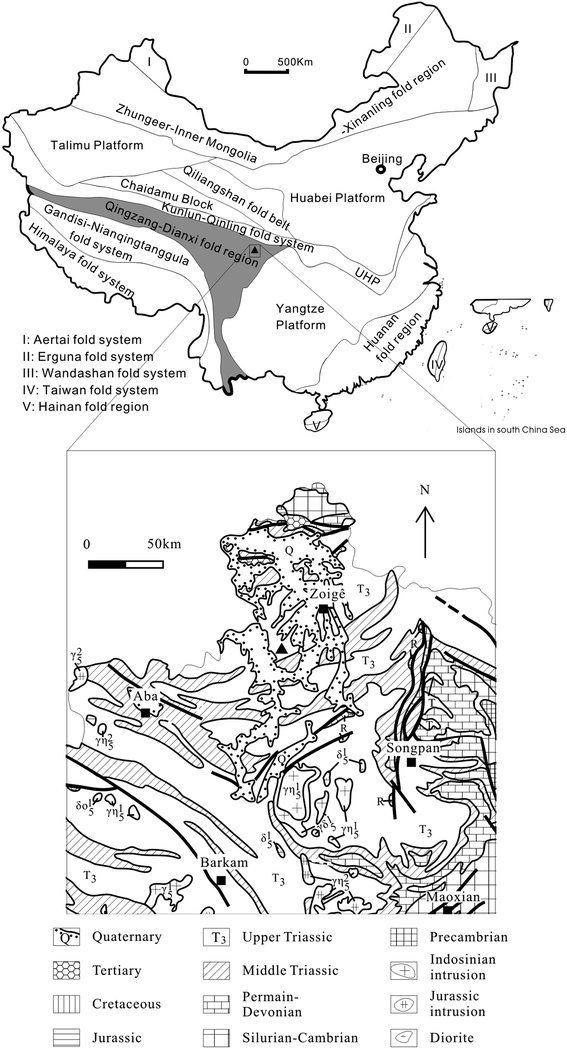
Tectonic map of China (from Ma et al. 2002). Greyness area represents the Qingzang-Dianxi fold region. Filled triangle marks the location of well Hongcan ane. UHP ultrahigh pressure metamorphic belt. Lower part is the geological sketch effectually the well. Filled triangle marks the locality of the well Hongcan 1
Geological setting
Tectonically the Triassic flysch in well Hongcan 1 has a circuitous geological history, belonging to the Songpan-Garzê orogen, which is limited by the north China, due south China and Indian blocks (Xu et al. 1992, 2007; Roger et al. 2008, 2010). From Early Paleozoic to Devonian times, the Songpan area was characterized by a large carbonate platform that extended towards the SE onto the Yangtze craton. By the end of Devonian, the area underwent extensive crustal stretching with the development of body of water crust (Nie et al. 1994; Zhou and Graham 1996; Weislogel et al. 2006; Weislogel 2008). Continent–continent collision betwixt the Northward and Southward China blocks during the Triassic resulted in the formation of the Qinling-Dabie orogen and acquired the closure of the Paleo-Tethys Ocean (Pullen et al. 2008). Large-scale foreland basins such every bit the Sichuan and the Songpan basins in the south developed on both sides of the collisional belt with syn-orogenic filling and closure of the basins. In the Carnian stage (T2–3), deep body of water turbidites were deposited in the Songpan basin (Zhang et al. 2008). Granitoid melts intruded into the flysch series during the belatedly Triassic to early on Jurassic menses (Hu et al. 2005). Early on magmatism preceded deformation (Xiao et al. 2007; Weislogel 2008) or was simultaneous with folding of the Triassic strata (Hu et al. 2005). Ongoing crustal thickening and shortening finally resulted in uplift of the chaff (Arne et al. 1997; Wang and Cai 2007).
Based on geophysical surveys and investigation of surface samples around Zoigê between 2002 and 2005, information technology was expected that the locality of the well Hongcan 1 would exist in a middle of diagenetic zone and about half-dozen km below the surface the lower Triassic-upper Permian carbonaceous rocks would occur in which large gas reserves were constitute in the neighboring Sichuan basin (Ma et al. 2005, 2007). Nonetheless, after drilling the borehole was discovered to be dominated by the upper-middle Triassic flysches in a sequence of alternate shales, silt- and sandstones with but minor carbonates. The electric current geothermal gradient of the borehole measured is xxx °C/km. The tectono-thermal evolution of the Songpan-Garzê orogen since the Mesozoic reflects the interactions between Indian and the South China and North China blocks, which was characterized past both magmatic activity and express uplift occurred during the Mesozoic, as well as large-calibration uplift and rapid cooling during the Tertiary Himalayan orogen (Huang et al. 2003).
Methods
This investigation is based on the study of 234 samples from well Hongcan i, which including 31 core samples taken from 31 core sections. Sample preparation of clay rich rocks followed the recommendations of the IGCP 294 (Kisch 1991). Dirt-sized fractions were separated using a HITACHI CR-22G centrifuge.
For XRD analyses, all measurements were performed with an X'Pert Pro MPD diffractometer with CuKα radiation and operating weather condition of xl kV and twoscore mA. The slit organisation was set with a 1° divergence, an anti-scatter slit of 2° and a 6.6 mm receiving anti-scatter slit for the 10'celerator detector. The stride size was set at 0.017° 2θ and the count time was 20 south. Mounts of randomly oriented majority powder were used for mineral phase identification measured in the range of 4–75° 2θ. Oriented slides of the <2 μm fraction were measured from 4 to 35° 2θ for clay mineral identification and IC and CC measurements. Considering nearly all samples comprise quartz, this mineral was used as an internal standard to make summit shift corrections.
For chemical composition analysis of minerals, electron microprobe analyses (EMPA) were performed using a JXA-8100 electron microprobe at 15 kV acceleration voltage and 10 nA beam electric current, a i μm axle diameter, a PRZ correction, and calibration against 53 minerals standards of SPI Corp. Ltd, United states of america. All Fe was calculated equally FeO. The thin sections for EMPA were oriented perpendicular to the stone fabric in lodge to reduce the influence of neighboring mineral grains.
Fluid inclusion analysis was performed with a MXM850 heating–cooling stage installed on an Olympus microscope system. The temperature was adjustable from room temperature up to 400 °C with a temperature resolution of 0.1 °C. The objective lens used was 32X. Sparse sections were prepared from those flysch samples containing a quartz veins lying parallel or subparallel to the bedding cloth.
Raman spectra were obtained with a confocal micro Raman arrangement Reshan-1000 and an excitation wavelength for 514.v nm line for an Ar ion laser operated at l mW. The scanning range was iii,000–500 cm−1 with ten s counting time. Each spectrum was measured with a twenty× objective and in single aggregating mode. The resolution was ±1 cm−1. Inorganic carbonaceous materials were collected from blackness flysch samples after handling with HF and HCl acids.
IC was measured as the full width at half maximum (FWHM) of the ca. 1 nm XRD reflection (002) of the white mica (illite) stage. The width expressed in °Δ2θ using CuKα radiations is known as the Kübler Index (Kübler 1964) and was calibrated based on a set of IC standards provided by Warr and Rice (1994). The IC boundaries for the anchizone are 0.25 and 0.42 °Δ2θ and equivalent CC measurements were fabricated using the FWHM of the chlorite (002) reflection (Árkai and Ghabrial 1997). Mixed-layer illite/smectite (I/South) phases were detected on the bases of the variations of the i nm "complex" reflection later glycolation, and heat treatment at 375 °C for an 60 minutes.
Decision of illite polytypes were performed past XRD method using random preparations measured over the diffraction range of 25–32°2θ, where the diagnostic reflections for iiG 1 and 1M polytype of illite could be identified. Decomposition procedures were used to separate the interference peaks overlapping the (112) reflection of aneChiliad structure and the (025) reflection of the twoM one structure of illite whereby all fitting reliabilities were below 3 %.
The b prison cell dimension of Thou-white micas was calculated from the relation b =d (060, −331) × 6 in which the d (060, −331) was measured using the quartz reflection (211) as an internal standard.
For chlorite chemic geothermometry (Inoue et al. 2009), EMPA information from core samples collected from the high anchizone and anchi-epizone transition were used. Such HA and A-E rocks are assumed to have attained equilibrium and thus be suitable for mineral geothermometer application. For calcite geobarothermometry, the pressure status is referred to about 3 kbar. See Sect. 4.6 for particular.
Results and discussions
Mineral assemblages
The master mineral phases recorded throughout borehole are quartz, feldspar, illite or muscovite and chlorite. Diagenetic minerals, namely mixed-layer illite/smectite (I/South) and chlorite/smectite (C/S) phases, and kaolinite occur between 0–3,042, 0–40 and 1,000 m respectively. The ordering type of I/S is R ≥ i and the corporeality of smectite in I/Due south ranges from 12 to 23 %. C/S is a randomly ordering type. The metamorphic index mineral graphite was plant in several segments below 5,038 m depth. EMPA composition information for calcite, illite, muscovite and chlorite is listed in Table ane.
Rock fabric
Effigy ii shows the changes in rock fabric with depth, which range from mudrocks and shales at the surface to slates, phyllites and even mylonites toward the bottom of the borehole. The diverse textural zones contain rocks with clay matrixes change from illite–smectite and chlorite-smectite assemblages to more than crystalline muscovite-chlorite assemblages at depth. Mudrocks (Fig. 2a, 100 1000) are characterized by no preferred orientation in the matrix, whereas the shales (Fig. 2b, 358.iv m) incorporate a sedimentary cloth within the clay matrix forming a thin beds and lamination. Illite-chlorite bearing slates (Fig. 2c HW-589, iv,375.ane thou) are characterized by new formed phyllosilicates orientating at low-angles to the sedimentary bedding. Muscovite-chlorite phyllites (Fig. 2d, 7,011.two k) contain neocrystallized phyllosilicates forming a series of cleavages penetrating the rocks, with strain-induced segregation of quartz and feldspar forming syn-tectonic mineralization. Three deformation cleavages S1–S3 were observed. S1 is penetrative and comprises of chlorite and muscovite (previously referred to every bit sericite, Rieder et al. 1998). This cleavage was overprinted by the S2 cleavage at an angle of 68°. S3 is restricted to a localized area and has an bending of twoscore° to S2. Because it is not possible to locate all 3 fabrics in the cored rocks, the observed S1–3 deformation phases cannot be directly linked to other geological structures. Mylonites contain (Fig. 2e, 6,073.2 g) an elongated and mortar texture of corroded quartz porphyroclasts and feldspar that occasional contain pressure shadows filled with newly formed phyllosilicates. While almost quartz porphyroclasts are elongated and rounded into to form augen like structures, some asymmetrical clasts indicate a sinistral shear sense (shearing management is marked past a pair of arrows in Fig. 2e).
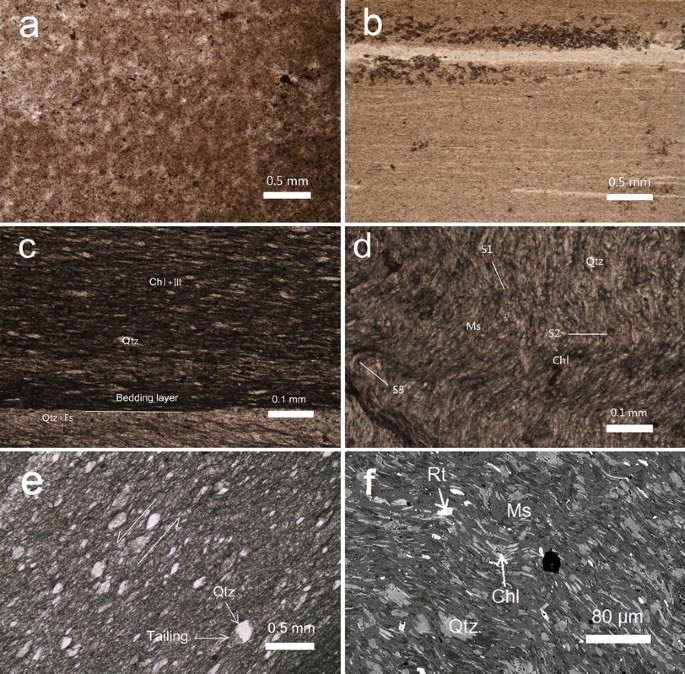
Texture variation with depth. a Mudrock, single polar, 100 m, HW-511, no orientation was observed in dirt matrix. b Shale, single polar, 358.4 thousand, HW-446, sedimentary lamination keeps well. c Slate, single polar, 4375.1 1000, HW-589, new formed clay minerals grow approximately forth bedding layer. d Phyllite, single polar, 7011.2 thousand, HW-734, phyllitic structure, penetrative schistosity with iii deformation phases developed. e Mylonite, single polar, 6073.two m, HW-732, augen structure. f Back-scattered electron scanning microscopy image, mircotexture of phyllite, 7011.2 m, HW-734, matrix is dominated past chlorite and muscovite; micro crenulation can be observed. Qtz quartz, Fs feldspar, Ms muscovite, Chl chlorite, Ill illite, Rt rutile
Illite "crystallinity" and chlorite "crystallinity"
IC values from well Hongcan i range between 0.234–0.679ºΔ2θ and CC values between 0.214–0.477ºΔ2θ. From the top to the lesser of the borehole, the IC Kübler index generally decreases from >0.60 to ca. 0.25ºΔ2θ (Fig. 3). Adopting accepted anchizone boundaries at 0.42 for the lower limit and 0.25ºΔ2θ for the upper limit (Kübler 1964; Merriman and Peacor 1999), the well tin be divided into the diagenetic zone (D, higher up 1,500 m), a transition from diagenetic zone to anchizone (D-LA, ane,500–3,270 m), the low anchizone (LA, iii,270–five,470 m), the high anchizone (HA, 5,470–6,000) and a transitional department from loftier-anchizone to epizone (HA-E, >6,000 k). A good correlation (Fig. 4) betwixt IC and CC was derived as:
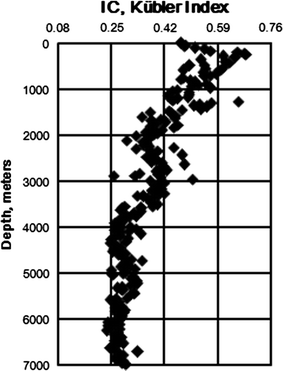
Variation of IC with depth in well Hongcan i
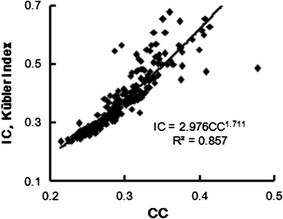
Correlation between IC and CC
$$ {\text{IC}} = 2. 9 seven 1 4 {\text{CC}}^{ 1. 7 x i} \quad \left( {R^{ 2} = 0. eight 5 7, \, N = 2 iii iii} \right). $$
(1)
Based on this correlation the boundaries of anchizone in terms of CC values are 0.314 and 0.242ºΔ2θ for the lower and upper limits. If weathered nigh surface sample (HW-462) is excluded likewise every bit sandstone and meta-sandstone lithologies, an even better correlation betwixt IC and CC inside those core samples is obtained as IC = five.356CC2.17, (R 2 = 0.912, Due north = 27). Weathering has likely oxidized the Fe+2 in chlorite to Fe+3 causing changes in the chlorite structure and alterations to crystallinity. The lack of correlation for many surfaces samples was also noted by Wang et al. (1996). Due the narrow range of CC values across the anchizone (just 0.07ºΔ2θ) this zone was not farther subdivided when based on CC measurement.
Illite polytypes
As pointed out by Frey (1987), the illite polytype transformation from 1Thou d to twoM 1 can be used equally an indicator of the state of diagenesis and very low grade metamorphism. The illite polytype in well Hongcan 1 was investigated by XRD analyses of random powder preparations which uses the integrated intensity ratio P = 2Thou i(I 025)/[1Grand(I 112) + 2M 1(I 025)], encounter Fig. 5 for particular. The total range of P in the well is 0.4–1 and from the surface to the bottom, a general increasing tendency of P exists from ca. 0.6–ane. However, because of the presentation of detrital mica the P is enhanced and 0 values for P in diagenetic rocks is not to be expected. Below 3,000 m the P increases, on average, to 0.61 at 3,000 m, to 0.73 between 3,000–iv,000 m, to 0.94 between 4,000–5,000 1000, to 0.98 betwixt 5,000–half dozen,000 m and to 0.99 at depths >6,000 m. A poor power functional correlation betwixt IC and P is derived as:
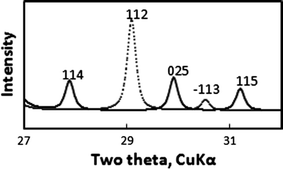
Measurement of illite polytype parameter P = 21000 1(I 025)/[iM(I 112) + twoK 1(I 025)]. There is a major divergence between iM and twoM one structures of illite, that is, d 112 (3.66 Å) of 1Yard illite and d 025 (2.988Å) of 2M one illite (co-ordinate to ICDD 2005). Because d 114 of 2Thou 1 structure is often interfered by feldspar's major reflections specially by the main reflection (three.19 Å) of albite and d −113 is too weak, the amount of twoK ane in the mixture of 1K + twoM 1 is measured and calculated using the integrated intensities of reflection (112) of 1M and (025) of 2Grand 1 illite for the sake of simplification. When other reflection appears the deconvolution technique was used and this way the pure reflections of 025 and 112 can be obtained
$$ {\text{IC}} = 0. 2 70{\text{P}}^{ - 0. 9 7} \quad \left( {N = 2 3 2,\;R^{ 2} = 0. 7 1 8} \right) $$
(2)
Quartz fluid inclusions
Some quartz veins were collected from core samples which occur parallel and subparallel to bedding (S0). The homogenization temperature and composition of fluid inclusions were determined and bold abiding composition and volume since trapping (Mullis 1987; Mullis et al. 2002), the results could be used to determine the lower limit of formation temperatures. Iii populations of homogenization temperatures (Table two) could be recognized that could besides exist distinguished by features of quartz morphology (Mullis 1987). The diagenetic zone contained primary quartz inclusions with the lower homogenization temperatures and compositions relatively rich in HHC. The quartz fluid inclusions plant in high anchizone testify a broad temperature range typical for both diagenetic to metamorphism weather but are notably rich in HtwoO. This mixture of homogenization temperature within the quartz particle is considered to stand for its long growth history. In these samples, the CH4 and the H2O Raman shifts were successfully detected at 2,914 and 3,000–3,300 cm−one corresponding to LA and A-E zones respectively (come across Fig. 6).
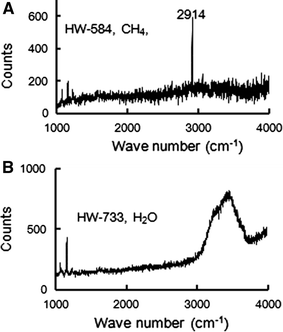
Raman spectroscopy of fluid inclusion trapped in quartz. a Methane and b water
Metamorphic pressure evaluation
Statistical analyses and cumulative frequency patterns of the G-white mica b cell parameter has been well investigated in metamorphic terrains of unlike types ranging from low to loftier force per unit area facies (Sassi and Scolari 1974). Metamorphic force per unit area plays a role in affecting the composition of mica series, with substitutions in IV and VI sites, also as in the interlayer (Guidotti and Sassia 2002). Structural analysis (based on ionic radii calculations, Shannon 1976) indicates that the substitutions with increasing force per unit area of Fe2+Mg↔Al3+ and Fe3+↔Althree+ within octahedrons plays a more than of import part in impacting mica structure than the Sifour+↔Al3+ exchange in tetrahedrons. This is in agreement with the statistic results of K-white mica geobarometer. From this signal of view, information technology is reasonable and reliable to use the G-white mica b cell geobarometer in the study of metamorphic pressure evaluation for very low class metamorphism of clastic rocks.
Table 3 lists these describing substitutions in muscovite and chlorite and the exchange coefficient One thousand D of the Tschermak substitution betwixt muscovite and chlorite. The meanings of the ratio of t, p and K D are referred to Miyashiro and Shido (1985). It shows from Table 3 that t, p and K D increment to a acme (5,847–half dozen,073 thousand) and then decrease consistently. This indicates that the amount of celadonite in muscovite and antigorite in chlorite increase and then decrease (Miyashiro and Shido 1985).
Existence a species of the mica group, the illite b cell dimension has the aforementioned pregnant as the muscovite b cell and has been widely used as a mica b cell geobarometer by many researchers (Padan et al. 1982; Yang and Hesse 1991; Wang et al. 1996; Gutierrez Alonso and Nieto 1996; Cruz and Jiménez 2002; Bozkaya and Yalçin 2005; Potel 2007; Brime et al. 2008; Kemp and Merriman 2009; Corrado et al. 2010; Offler et al. 2011). K-white mica b cell values of 52 samples were measured from the Triassic flysches in well Hongcan 1. The values range from 0.8992 to 0.9023 nm, with an boilerplate of 0.9008 nm. As derived from the cumulative frequency curves of the b prison cell values (Fig. vii), the pressure condition beneath five,470 m (HA to A-E) is a lilliputian lower than the N. New Hampshire pressure type (low intermediate, Rumble 1973; Guidotti and Sassia 1986). Co-ordinate to Guidotti and Sassia (1986) the average b cell value of core samples (9.008 Å, close to the nine.010 Å line) corresponds to c. 3 kbar, for the high anchizone (HA) and anchi-epizonal (A-Due east) equivalent temperatures. The estimated erosion (>3.8 km) and depth (7 km) of Triassic in the well Hongcan-one (Agency of geology and mineral resources of Sichuan province 1991; Li et al. 2006) are also compatible with pressure status around 3 kbar.
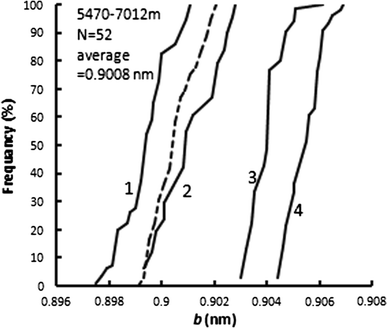
Cumulative frequency curves of Grand-white mica b cell dimension. Solid line one Bosos low pressure blazon, solid line 2 N. New Hampshire depression intermediate pressure level blazon, solid line three Otago intermediate high pressure type, solid line four Sanbagawa high force per unit area type, shaded line represents the cumulative frequency curves of Thousand-white mica b cell dimensions from HA and A-Eastward transition (5,470–7,000 g)
Temperature evaluation
The chlorite chemic geothermometer (Inoue et al. 2009), calcite–dolomite (Cc–Do) geobaro-thermometer (Goldsmith et al. 1955; Goldsmith and Newton 1969; Bickle and Powell 1977; Turner 1981) and homogenization temperature of quartz fluid inclusions were used to evaluate the metamorphic peak temperature of Triassic flysches in well Hongcan 1. All temperature information are listed in Table 2. Because application of mineral geothermometer requires equilibrium assemblages only flysch of the HA and A-E transition was used (Note in Fig. 3f the chlorite and muscovite in the A-East transition sample are in equilibrium). Chlorite is composed by two tetrahedral and ii octahedral sheets, the temperature would affect on both of them. It is clear that chlorite Al Four site geothermometer (Cathelineau 1988) obtains temperature information merely from empirical data near Iv site while the chlorite chemical geothermometer (Inoue et al. 2009) calculates temperature, using a thermodynamic approach from both IV and VI sites. For this reason we accept chosen the chlorite chemical geothermometer for temperature evaluation.
X-ray diffractometry is a more than statistically valid approach as information technology measures countless pocket-sized particles of minerals without limitations in dimension and it has been widely used in analyzing very low grade metamorphic rocks. It is well known that rocks of greenschist facies and higher metamorphic facies are well crystallized and when their minerals are in equilibrium those geothermometers and geobarometers tin be applied. However, it should continue in listen that minerals in equilibrium should not be limited by the effective resolution of the microscope (ii μm) or EMPA (1 μm). Minerals in equilibrium can rationally exist less than 1–ii μm in size. The full general temperatures variations with depth in the well Hongcan one based on all methods are shown in Fig. viii. All indicate increasing temperatures with decreasing depth in the Triassic flysch corresponding to the diagenetic to epizonal transition.
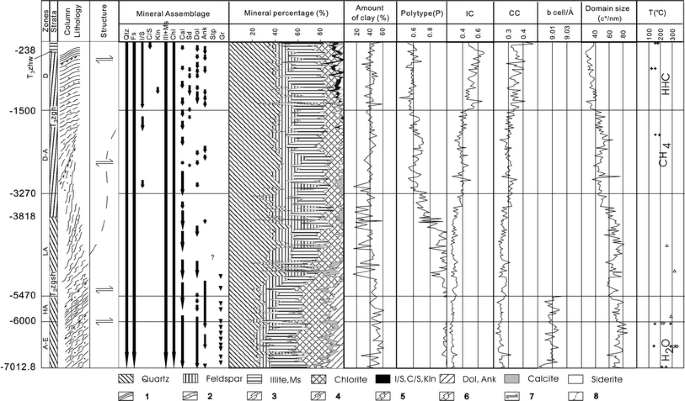
Comprehensive variations of all evolutionary parameters from diagenesis to very low class metamorphism with depth of well Hongcan 1. D diagenetic zone, D-A transition between diagenetic zone and anchizone, LA low anchizone, HA high anchizone, A-Due east transition between anchizone and epizone, T 3 zhw Zhuwu formation of upper Triassic, T 3 zgn Zagunao formation of upper Triassic, T 2 zgsh Zagashan formation of middle Triassic, Qtz quartz, Fs feldspar, Ill illite, Ms muscovite, Chl chlorite, I/S illite/smectite mixed-layer phase, C/S chlorite/smectite mixed-layer phase, Kln kaolinite, Cal calcite, Sd siderite, Dol dolomite, Ank ankerite, Stp stilpnomelane, Gr graphite, IC "illite crystallinity", CC "chlorite crystallinity", P = 2M025/(2M025 + 1M112), HHC higher hydrocarbons, CH 4 methane, H 2 O water, T formation temperature. Numbers with a minus sign by the left of column indicate the depth downwardly from the ground surface. Legend 1 shale, 2 fine sandstone, 3 meta-sandstone, four slate, 5 phyllite, 6 marble, 7 detachment, 8 folding trace. Plus sign indicates homogenization temperature of fluid inclusion in quartz; triangle indicates temperature evaluated by Cc–Practise geobarothermometer; open circumvolve indicates temperature evaluated past chlorite chemical geothermometer (Inoue et al. 2009)
The tectono-thermal history can be summarized as follows. Following deposition in a deep body of water environs of the Paleo-Tethys ocean, and accumulations of roughly 5–7.v km thick turbidites in the Songpan bowl during the Carnian stage (T2–3) (p219, the Bureau of Geology and Mineral Resources of Sichuan Province 1991), collision between the south and the north China blocks caused a folding of Triassic flysches (see the geological sketch around the well in Fig. ane) and structural thickening of the sequence to over 7 km in the well Hongcan 1 or 10–xv km in the area almost Zoigê (airtight fold or intrafolial fold produced in the Triassic flysch strata an increase of, at to the lowest degree, 2 times in thickness, Zhao et al. 2004). Structural overloading in a foreland basin setting is suggested to have been responsible for the increasing temperature at depth (350 °C/10 km for a normal gradient 35 °C/km), inducing anchimetamorphism at the lesser of Triassic flysches. This temperature agrees well with 348 °C evaluated from the chlorite chemic geothermometer. With increasing depth, the decreasing of IC and CC, increasing of P, rock material development from no preferred orientation in the matrix to penetrating cleavages, fluid inclusion in quartz from HHC zone to CH4 and to H2O zone and the mineral assemblage from illite-I/S–C/Southward-chlorite to muscovite-chlorite; all of them consistently indicate the increment in grade. "Fold overloading model" is therefore proposed to depict the anchimetamorphism of the Triassic flysches in the well. In the eastern Sichuan bowl, the neighboring expanse, where the Triassic consists of about 1,800 m carbonaceous limestone of Ti–2 and 1,500 clastic rocks of Tiii, the structural overloading was non able to cause very low course metamorphism due to the thinner thickness of the Triassic strata. Post-metamorphic structural movements (shearing) produced a series of detachments within the Triassic flysches (mylonites) at different levels of the well, which were related to the development of S2–3 cleavages. The Xianshuihe fault produced a strike-slip movement in the early on 3rd and disturbed the distribution of metamorphic zones (Wang et al. 2011). Finally the Himalayas movement acquired uplift and denudation of the Triassic flysch (>3.8 km erosion since Cretaceous, Bureau of geology and mineral resource of Sichuan province 1991, Li et al. 2006), merely this final event had fiddling influence on the distribution of the very-depression form metamorphic rocks.
Conclusions
The 7 km thick Triassic flysch sequence penetrated by well Hongcan 1 shows a continuous increment in metamorphic grade with depth ranging from tardily diagenesis in the upper ane,500 m to epizonal conditions at bottom of the borehole.
Fluid inclusions within quartz from core samples are consistent with the course changes with a higher hydrocarbon zone corresponding to the diagenetic rocks, a marsh gas zone within the diagenetic to anchizone rocks and a h2o zone (H2O) respective to the anchizone-epizone transition.
The tiptop metamorphic pressure condition experienced by the Triassic flysch was slightly lower than the intermediate-depression pressure weather condition and peak temperature reached 348 °C. The diagenetic to epizonal metamorphism of the studied sequence reflects structural thickening of the Triassic sedimentary rocks.
References
-
Árkai, P., & Ghabrial, D. S. (1997). Chlorite crystallinity equally an indicator of metamorphic grade of low-temperature meta-igneous rocks: A instance written report from the Bukk mountains, northeast Hungary. Dirt Minerals, 32, 205–222.
-
Arne, D., Worley, B., Wilson, C., Chen, S. F., Foster, D., Luo, Z. 50., et al. (1997). Differential exhumation in response to episodic thrusting along the eastern margin of the Tibetan plateau. Tectonophysics, 280, 239–256.
-
Bickle, M. J., & Powell, R. (1977). Calcite–dolomite geothermometry for fe-bearing carbonates. Contributions to Mineralogy and Petrology, 59, 281–292.
-
Bozkaya, Ö., & Yalçin, H. (2005). Diagenesis and very depression-class metamorphism of the Antalya unit of measurement: Mineralogical show of Triassic rifting, Alanya-Gazipaşa, fundamental Taurus belt, Turkey. Journal of Asian Globe Sciences, 25, 109–119.
-
Brime, C., Perri, M. C., Pondrelli, Thou., Spalletta, C., & Venturini, C. (2008). Polyphase metamorphism in the eastern Carnic Alps (N Italy-Due south Austria): Clay minerals and conodont Colour Alteration Index evidence. International Periodical of Earth Sciences, 97, 1213–1229.
-
Bureau of geology and mineral resources of Sichuan province (1991). Regional geology of Sichuan province, Cathay (736 pp). Beijing: Geological Publishing House (in Chinese with English abstruse).
-
Cathelineau, M. (1988). Cation site occupancy in chlorites and illites every bit a function of temperature. Clay Minerals, 23, 471–485.
-
Chen, Thou., He, West. J., Liang, B., & Xie, Q. Ten. (2001). Characteristics of very low grade metamorphic rocks in the Xikang Grouping of northwest Sichuan. Acta Geologica Sichuan, 21, 65–69. (in Chinese with English language abstract).
-
Chung, S. L., Chu, M. F., Zhang, Y. Q., Xie, Y. W., Lo, C. H., Lee, T. Y., et al. (2005). Tibetan tectonic evolution inferred from spatial and temporal variations in post-collisional magmatism. Earth-Scientific discipline Reviews, 68, 173–196.
-
Corrado, Southward., Invernizzi, C., Aldega, 50., D'Errico, Yard., Di Leo, P., Mazzoli, S., et al. (2010). Testing the validity of organic and inorganic thermal indicators in different tectonic settings from continental subduction to collision: The instance history of the Calabria-Lucania edge (southern Apennines, Italy). Journal of the Geological Society, 167, 985–999.
-
Cruz, M. D. R., & Jiménez, P. R. (2002). Correlation between crystallochemical parameters of phyllosilicates and mineral facies in very low-grade metasediments of the Betic Cordilleras, Spain: A synthesis. Clay Minerals, 37, 169–185.
-
Dong, S. D., Shen, Q. H., Sun, D. Z., & Lu, L. Z. (1986). Metamorphic map of China on a scale of 1/4000000. Beijing: Geological publishing business firm.
-
Frey, M. (1987). Very depression-grade metamorphism of clastic sedimentary rocks. In M. Frey (Ed.), Depression temperature metamorphism (pp. 9–58). Glasgow and London: Blackie.
-
Goldsmith, J. R., Graf, D. R., & Joensun, K. I. (1955). The occurrence of magnesium calcite in nature. Geochimica et Cosmochimica Acta, 7, 212–230.
-
Goldsmith, J. R., & Newton, R. C. (1969). P-T relations in the arrangement CaCO3-MgCO3 at loftier temperature and pressures. American Periodical of Scientific discipline, 267A, 160–190.
-
Guidotti, C. Five., & Sassia, F. P. (1986). Classification and correlation of metamorphic facies serial by means of muscovite b0 information from low-grade metapelites. Neues Jahrbuch für Mineralogie Abhandlungen, 153, 363–380.
-
Guidotti, C. Five., & Sassia, F. P. (2002). Constrains on studies of metamorphic Thou-Na white micas. Reviews in Mineralogy and Geochemistry, 46, 413–448.
-
GutierrezAlonso, 1000., & Nieto, F. (1996). White-mica 'crystallinity', finite strain and cleavage development across a large Variscan structure, NW Spain. Periodical of the Geological Lodge, London, 153, 287–299.
-
Hu, J. Thou., Meng, Q. R., Shi, Y. R., & Qu, H. J. (2005). SHRIMP U-Pb dating of zircons from granitoid bodies in the Songpan-Garzê terrane and its implications. Acta Petrologica Sinica, 21, 867–880. (in Chinese with English abstract).
-
Huang, M. H., Buick, I. S., & Hou, L. Westward. (2003). Tectonometamorphic evolution of the eastern Tibet Plateau: Testify from the central Songpan-Garze Orogenic Belt, western Cathay. Journal of Petrology, 44, 255–278.
-
Inoue, A., Meunier, A., Patrier-Mas, P., Rigault, C., Beaufort, D., & Vieillard, P. (2009). Application of chemic geothermometry to low-temperature trioctahedral chlorites. Clays and Clay Minerals, 57, 371–382.
-
Kemp, S. J., & Merriman, R. J. (2009). Polyphase low-grade metamorphism of the Ingleton Grouping, northern England, U.k.: A case study of metamorphic inversion in a mudrock succession. Geological Magazine, 146, 237–251.
-
Kisch, H. J. (1991). Illite crystallinity: Recommendations on samples preparation, X-ray diffraction settings, and interlaboratory samples. Periodical of Metamorphic Geology, 9, 665–670.
-
Kübler, B. (1964). Les argiles, indicateurs de metamorphisme. Pevue Instituté de la Français Pétrole, 19, 1093–1112.
-
Li, Y., Zhou, R. J., Densmore, A. L., Ellis, M. A., & Li, Y. Z. (2006). Continental dynamics and geological responses of the eastern margin of Qinghai-Tibet plateau (148 pp.). Beijing: Geological Publishing House (in Chinese with English abstract).
-
Ma, Y. S., Cai, X. Y., & Li, G. X. (2005). Basic characteristics and concentration of the Puguang Gas field in the Sichuan Basin. Acta Geologica Sinica (Chinese edition), 79, 858–865.
-
Ma, Y. S., Fu, X. Y., Wu, J. South., & Chen, Thou. (2007). Crustal structural and tectonic evolution and oil prospect evaluation in the Songpan-Zoigê block. Acta Geologica Sinica (English language edition), 81, one–x.
-
Ma, L. F., Qiao, Ten. F., Min, L. R., Fan, B. X., & Ding, Ten. Z. (2002). Geological atlas of China (348 pp.). Beijing: Geological Publishing House (in Chinese).
-
Merriman, R. J., & Peacor, D. R. (1999). Very low-class metapelites: Mineralogy, microfabrics and measuring reaction progress. In M. Frey & D. Robinson (Eds.), Low grade metamorphism (pp. 10–60). London: Blackwell.
-
Miyashiro, A., & Shido, F. (1985). Tschermak substitution in low- and heart-grade pelitic schists. Journal of Petrology, 26, 449–487.
-
Mullis, J. (1987). Fluid inclusion studies during very depression class metamorphism. In M. Frey (Ed.), Depression temperature metamorphism (pp. 162–199). London: Blackwell.
-
Mullis, J., Rahn, M. M., Schwer, P., de Capitani, C., Stern, W. B., & Frey, M. (2002). Correlation of fluid inclusion temperatures with illite "crystallinity" information and clay mineral chemical science in sedimentary rocks from the external office of the Central Alps. Schweizerische Mineralogische und Petrographische Mitteilungen, 82, 325–340.
-
Nie, South. Y., Yin, A., Rowley, D. B., & Jin, Y. One thousand. (1994). Exhumation of the Dabie Shan ultra high-pressure rocks and accumulation of the Songpan-Garzê flysch sequence, central Mainland china. Geology, 22, 999–1002.
-
Offler, R., Phillips, M., Fergusson, C. L., & Greenish, T. J. (2011). Tectonic implications of early paleozoic metamorphism in the Anakie Inlier, Key Queensland, Australia. Journal of Geology, 119, 467–485.
-
Padan, A., Kisch, H. J., & Shagam, R. (1982). Use of the lattice parameter b 0 of dioctahedral illite/muscovite for the characterization of P/T gradients of incipient metamorphism. Contributions to Mineralogy and Petrology, 79, 85–95.
-
Potel, S. (2007). Very low-grade metamorphic study in the pre-Late Cretaceous terranes of New Caledonia (southwest Pacific Ocean). The Island Arc, 16, 291–305.
-
Pullen, A., Kapp, P., Gehrels, Thousand. E., Vervoort, J. D., & Lin, D. (2008). Triassic continental subduction in central Tibet and Mediterranean-style closure of the Paleo-Tethys Ocean. Geology, 36, 351–354.
-
Rieder, M., Cavazzini, One thousand., D'Yakonov, Y., Frank-Kamenetskii, V. A., Gottardi, Thousand., Guggenheim, South., et al. (1998). Nomenclature of the micas. Canadian Mineralogist, 36, 905–912.
-
Roger, F., Jolivet, Thousand., & Malavieille, J. (2008). Tectonic evolution of the Triassic fold belts of Tibet. Comptes Rendus Geoscience, 340, 180–189.
-
Roger, F., Jolivet, G., & Malavieille, J. (2010). The tectonic evolution of the Songpan-Garzê (North Tibet) and adjacent areas from Proterozoic to Present: A synthesis. Periodical of Asian Earth Sciences, 39, 254–269.
-
Rumble, D, I. I. I. (1973). Andalusite, kyanite and sillimanite from the Mount Mooselauke Region, New Hampshire. Geological Society of America Bulletin, 84, 2423–2430.
-
Sassi, F. P., & Scolari, A. (1974). The b 0 value of the potassium white micas equally a barometric indicator in low-grade metamorphism of pelitic schists. Contributions to Mineralogy and Petrology, 45, 143–152.
-
Shannon, R. D. (1976). Revised effective ionic radii and systematic studies of interatomic distances in Halides and Chalcogenides. Acta Crystallographica, A32, 751–767.
-
She, Z. B., Ma, C. Q., Mason, R., Li, J. W., Wang, Grand. C., & Lei, Y. H. (2006). Provenance of the Triassic Songpan-Garze flysch, west China. Chemical Geology, 231, 159–175.
-
Turner, F. J. (1981). Metamorphic petrology: Mineralogical, field, and tectonic aspects (524 pp). 2nd edition. New York: McGraw-Hill Book Company, Hemisphere Publishing Corporation.
-
Wang, Q. C., & Cai, L. G. (2007). Phanerozoic tectonic evolution of South China. Acta Geologica Sinica-Chinese Version, 81, 1025–1040. (in Chinese with English abstruse).
-
Wang, H., Frey, M., & Stern, West. B. (1996). Diagenesis and metamorphism of clay minerals in the Helvetic Alps of Eastern Switzerland. Clays and Clay Minerals, 44, 96–112.
-
Wang, H. J., Rahn, M., Tao, X. F., Zheng, Northward., & Xu, T. J. (2008). Diagenesis and metamorphism of Triassic flysch along profile Zoigê-Lushan, northwest Sichuan, Cathay. Acta Geologica Sinica, 82, 917–926.
-
Wang, H., Rahn, M., Zhou, J., & Tao, X. (2011). Tectonothermal development of the Triassic flysch in the Songpan-Garzê orogen, eastern margin of Tibetan plateau. Mineralogical Magazine, 75(three), 2117.
-
Warr, L. N., & Rice, A. H. N. (1994). Interlaboratory standardization and calibration of dirt mineral crystallinity and crystallite size data. Journal of Metamorphic Geology, 12, 141–152.
-
Weislogel, A. 50. (2008). Tectonostratigraphic and geochronologic constraints on evolution of the northeast Paleotethys from the Songpan-Ganzi complex, central Communist china. Tectonophysics, 451, 331–345.
-
Weislogel, A. Fifty., Graham, South. A., Chang, E. Z., Wooden, J. L., Gehrels, Thousand. Eastward., & Yang, H. (2006). Detrital zircon provenance of the Late Triassic Songpan-Garzê circuitous: Sedimentary record of collision of the North and South People's republic of china blocks. Geology, 34, 97–100.
-
Xia, Z. S. (1993). Synorogenic regional anchi-metamorphism of Triassic terrigenous clastic rock in Songpan-Garze orogenic belt in early Yanshan epoch. Acta Geologica Sichuan, 13, 189–192. (in Chinese with English language abstract).
-
Xiao, 50., Zhang, H. F., Clemens, J. D., Wang, Q. Due west., Kan, Z. Z., Wang, Grand. M., et al. (2007). Late Triassic granitoids of the eastern margin of the Tibetan plateau: Geochronology, petrogenesis and implications for tectonic evolution. Lithos, 96, 436–452.
-
Xu, Z. Q., Hou, L. Westward., & Wang, Z. Ten. (1992). Orogenic processes of the Songpan-Garze orogenic belt of China. Beijing: Geological publishing house (in Chinese).
-
Xu, Z. Q., Yang, J. S., Li, H. B., Zhang, J. 10., & Wu, C. L. (2007). Orogenic plateau-terrane amalgamation, collision and uplift in the Qinghai-Tibet Plateau (458 pp). Beijing: Geological publishing firm (in Chinese with English language abstruse).
-
Yang, C., & Hesse, R. (1991). Clay minerals as indicators of diagenetic and anchimetamorphic grade in an overthrust chugalug external domain of southern Canadian Appalachians. Clay Minerals, 26, 211–231.
-
Yang, Q., & Liu, L. W. (2005). Experimental study on diagenetic development for Triassic in the Songpan-Aba area. Petroleum Geology and Experiment, 27, 534–538. (in Chinese with English abstract).
-
You, Z. D., Cheng, Southward. H., & Lai, 10. Y. (2006). The Danba domal metamorphic terrane, western Sichuan, China. Earth Scientific discipline Frontiers, thirteen, 148–159. (in Chinese with English language abstract).
-
Zhang, K. J., Li, B., Wei, Q. G., Cai, J. X., & Zhang, Y. X. (2008). Proximal provenance of the western Songpan–Ganzi turbidite complex (Late Triassic, eastern Tibetan plateau): Implications for the tectonic affiliation of Cathay. Sedimentary Geology, 208, 36–44.
-
Zhao, D. J., Wu, S., & Wu, D. C. (2004). The stages of the folds and its outcome on lithostratigraphy in the Jinping hydropower station region of the Yalong river. Advance in earth sciences, 19, suppl., threescore-65 (in Chinese with English abstruse).
-
Zhou, D., & Graham, S. A. (1996). Songpan-Garzê circuitous of west Qingling Shan equally Triassic remnant ocean basin fill up trapped during the Mesozoic tectonic amalgamation of Mainland china. In A. Yin & M. Harrison (Eds.), The tectonic evolution of Asia (pp. 281–299). Cambridge: Cambridge Academy Press.
-
Zhou, M. F., Yan, D. P., Vasconcelos Paulo, M., Li, J. Due west., & Hu, R. Z. (2008). Structural and geochronological constraints on the tectono-thermal evolution of the Danba domal terrane, eastern margin of the Tibetan plateau. Journal of Asian Earth Sciences, 33, 414–427.
Acknowledgments
The first author had been grateful to Prof. Martin Frey who guided him to the field of very depression grade metamorphism during 1990–2000. We besides thank Prof. F. Nieto's effort on this paper and two anonymous reviewers' comments. This written report is supported by the project of SINOPEC Grouping No. G0800-05-ZS-(KJ-05-06) and the National Natural Scientific discipline Foundation of Red china (Grants No. 40972038, 40872034 and 40572032).
Writer data
Affiliations
Corresponding writer
Boosted information
Editorial treatment: Fernando Nieto García and Edwin Gnos.
Rights and permissions
About this article
Cite this article
Wang, H., Ma, Y., Zhou, J. et al. Diagenesis and very depression form metamorphism in a vii,012 m-deep well Hongcan 1, eastern Tibetan plateau. Swiss J Geosci 105, 249–261 (2012). https://doi.org/x.1007/s00015-012-0105-5
-
Received:
-
Accepted:
-
Published:
-
Result Date:
-
DOI : https://doi.org/10.1007/s00015-012-0105-5
Keywords
- Diagenesis
- Very-depression-grade metamorphism
- Illite crystallinity
- Triassic flysch
- Tibetan plateau
Source: https://sjg.springeropen.com/articles/10.1007/s00015-012-0105-5
0 Response to "The Transformation of Clay Minerals During Diagenesis and Low-grade Metamorphism a Review"
Post a Comment